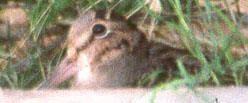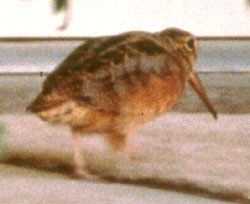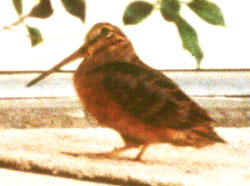 This
individual was first found by Michael Patten, Guy McCaskie and Dan Cooper on 3 November 1998. It was also seen
and photographed by Don Roberson on 9 November 1998. Iron Mountain is sensitive private property and access is
restricted.
This
individual was first found by Michael Patten, Guy McCaskie and Dan Cooper on 3 November 1998. It was also seen
and photographed by Don Roberson on 9 November 1998. Iron Mountain is sensitive private property and access is
restricted.American Woodcock
Iron Mountain Pump Station
San Bernardino County, California
7 November 1998
 This
individual was first found by Michael Patten, Guy McCaskie and Dan Cooper on 3 November 1998. It was also seen
and photographed by Don Roberson on 9 November 1998. Iron Mountain is sensitive private property and access is
restricted.
This
individual was first found by Michael Patten, Guy McCaskie and Dan Cooper on 3 November 1998. It was also seen
and photographed by Don Roberson on 9 November 1998. Iron Mountain is sensitive private property and access is
restricted.
While birding with Matt Heindel and others at the Orange County agricultural Field in Irvine, Matt received
a call on his cellular phone from Michael Patten informing us that an American Woodcock had reappeared at the Iron
Mountain Pump Station.
Robbie Fischer and I decided leave the Lapland and McCown’s longspurs and try for the woodcock. We left about 12:15pm and arrived at Iron Mountain about 3:30pm. We almost immediately saw the woodcock on the lawn adjacent to the third house from the northeast corner of the housing complex, exactly where Michael Patten had reported it. The bird scurried behind the house and along the chain link fence quickly disappearing under a leafy shrub at the northwest corner of the house. I felt that the bird had probably not left the area and decided to wait with my telescope (KOWA TSN-4) while Robbie explored the ditch behind the houses. Soon Karen Gilbert arrived and I managed to locate the woodcock which was hiding deep in the vegetation. I got it in my scope and we were afforded frustrating partial views of the bird for the next half hour. Suddenly the bird scurried down the fence line toward the rear and I located it again in my scope, but it was still partly concealed behind some dead twigs.
 During
this time the owner of the adjacent house was loudly vacuuming his car in the driveway right next to the bird,
dogs were barking and there was considerable noise and commotion which did not seem to be disturbing to the bird.
Karen and I walked around the back trying to get a better angle while Robbie got permission from Jim Craig, the
fellow who had been vacuuming his car, for us to view the bird from his driveway. He was very cordial and delighted
to let us view the bird. Here we got scope filling views of the bird in diffused light and were able to watch the
bird as it walked slowly pumping its body up and down in a wobbly dance while it held its head perfectly still.
We were aware that the bird might be skittish as it had apparently flown away, not to be refound in the past, so
we were careful not to press too close, but the bird seemed extraordinarily tame during our period of observation.
During
this time the owner of the adjacent house was loudly vacuuming his car in the driveway right next to the bird,
dogs were barking and there was considerable noise and commotion which did not seem to be disturbing to the bird.
Karen and I walked around the back trying to get a better angle while Robbie got permission from Jim Craig, the
fellow who had been vacuuming his car, for us to view the bird from his driveway. He was very cordial and delighted
to let us view the bird. Here we got scope filling views of the bird in diffused light and were able to watch the
bird as it walked slowly pumping its body up and down in a wobbly dance while it held its head perfectly still.
We were aware that the bird might be skittish as it had apparently flown away, not to be refound in the past, so
we were careful not to press too close, but the bird seemed extraordinarily tame during our period of observation.
Finally as it was getting dark around 5pm the bird scurried behind the back fence and disappeared. Altogether we had the bird in view for approximately an hour through the scope during the two hours we were there. The following description is based on notes made while watching the bird and from memory:
This was a rather largish, oddly shaped bird. Nothing else is remotely shaped like a woodcock. It was very wide and plump, with a very short tail, very long thick bill, very wide relatively massive head with its large eyes located far apart on the side of the head and nearer the top of the head. The large head was attached directly to the body with no visible neck extension.
The bird was overall gray, black and buff above and rich buff on the entire underparts. However the bird was extremely difficult to describe because of the complexity of the upperpart pattern and the difficulty of diagnosing which feather tracts were involved in the various patterns.
The face was rich buff. The large dark eyes were surrounded by a broken eyering, buff above, and white with a bluish cast below. The crown was black with three narrow buff transverse bars within the black. A black line extended forward from the eye to the bill, but was narrower behind the eye. Another dark line extended horizontally across the face below the eye.
The bill was very long and quite thick, especially at the base. The basal 1/3rd of the bill was paler than the gray brown tip and suffused with pinkish on the lower mandible.
The back had alternating rows of blackish, gray and buff feathers. The center of the back appeared grayish with fine buff marbling caused by vermiculations on both webs on the outside of each feather. This gray area contrasted with a zone of large black upper scapulars which were shaped somewhat like cordate leaves with acuminate tips and serrate or notched edges. Each of these black feathers was fringed with a narrow band of rich buff.
Below the upper scapulars were several rows of lower scapulars which appeared gray in color and showed more obvious buff vermiculations on the fringes of the base of each feather compared to the finer markings on the gray feathers of the upper back. The tips of these lower scapular feathers appeared slightly worn and I was under the impression that the bird was molting, probably showing two generations of feathers, but I am not sure of this. The black scapulars appeared fresh while the gray ones appeared old.
The wing coverts were darker gray with extensive light buff vermiculations throughout forming a very complex pattern which contrasted with the longer gray scapulars.
The uppertail coverts were buff with coarse transverse vermiculations. The blackish tip of the tail may have been visible beyond the coverts, but I am not sure. The tail was mostly hidden.
The underparts appeared to be a uniform rich-buff throughout, without streaks or bars. The legs were short and dull pinkish.
Discussion
All features support the identification of this bird as an American Woodcock (Scolopax minor) although there are several other species found in the eastern hemisphere which need to be eliminated. The most widespread is the Eurasian Woodcock (S. rusticola) which has obvious barring on the underparts, less gray above and larger size. The Amami Woodcock (Scolopax mira) localized on islands south of Japan and Dusky Woodcock (S. saturata) of Indonesia differ in the same ways, having dusky barring on the underparts. The Celebes Woodcock (S. celebensis) of Sulawesi and the Obi Woodcock (S. rochussenii), known only from five specimens and last seen in 1902, have unmarked rich buff underparts similar to American Woodcock, but lack the gray scapulars and back feathering evident on the American Woodcock. An undescribed Asian woodcock from the Philippines may be a subspecies of S. celebensis or S. saturata or a possibly a new previously undescribed species (Harrap & Fischer 1994).
All of these except Eurasian Woodcock are very localized on East Asiatic islands and are nonmigratory (Hayman et al. 1986). There is no question that the Iron Mountain bird was an American Woodcock.
This is the first apparently wild American Woodcock found in California although this species was released as a potential game species by the California Department of Fish and Game in the early 1970’s. The following release history is from Kidd & Harper (1974):
Colusa Co. 1973 61 birds Sacramento Co. 1972-74 294 birds Sutter Co. 1972-73 81 birds Sonoma Co. 1972 61 birds San Joaquin Co. 1973 33 birds Butte Co. 1973 29 birds Mendocino Co. 1972 40 birds Total 599 birds
During this period a total of 663 woodcocks were trapped in Louisiana and shipped to California. 64 birds died in transit and 599 were released. 15 birds were subsequently seen or found dead during 1972-73. Of these 10 were near release sites (Elk Grove, Santa Rosa, Thornton and Hopland), but one was seen 120 miles northwest of Anchorage, Alaska (Oct 19, 1972); one was found dead at Cummings Lake, Ely, Nevada (March 13, 1972) one was hit by a car in Alberta, Canada (Jan 20, 1972), and one was shot by a hunter in Eastern Kansas, Blue River (Nov 19, 1973). Bands on the last three prove they were from California releases, but the Alaska sighting could possibly have been of a wild bird. There is no indication in the report why it was assumed to be a California release (Kidd and Harper 1974)
The species is migratory and ranges far enough north that the possibility of natural vagrancy, especially in such a remote desert oasis, seems reasonable. The only prior West Coast record is 5 March 1960 at North Surry, British Columbia but there is also a 1 October 1983 record from Ninemile Creek in western Montana (Paulson 1993). One reported 16 February 1976 in Southeastern Arizona is regarded as hypothetical (Monson and Phillips 1981). The nocturnal habits of this species make detection away from the breeding grounds very difficult and it is possible the species could easily go undetected.
Aging of this species is very difficult. Stout (1967) states that in juvenal plumage the "feathers of upperparts, such as scapulars and tertials, have large subterminal dark area and light tip (pattern is more broken in later plumages); there is indistinct dark barring on wing-coverts (in older stages these feathers have distinct barring: black, then a light bar, a narrow irregular dark bar, and finally light edging)..." However postjuvenal molt is quite early and Basic I is acquired by October. This is a partial molt. Adults have a similar molt including many wing-coverts. It is possible that photographs may be able to help assess the age of this individual.
References
--
Joseph Morlan
380 Talbot Avenue #206
Pacifica, CA 94044
jmorlan@ccsf.cc.ca.us